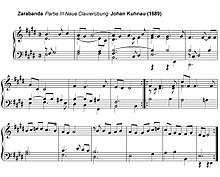Sarabande
The sarabande (from Spanish: zarabanda) is a dance in triple metre.

History
The dance may have been of Guatemalan and Mexican origin evolved from a Spanish dance with Arab influences, danced with a lively double line of couples with castanets.[1][2] A dance called zarabanda is first mentioned in 1539 in Central America in the poem Vida y tiempo de Maricastaña, written in Panama by Fernando de Guzmán Mejía.[3][4] The dance seems to have been especially popular in the 16th and 17th centuries, initially in the Spanish colonies, before moving across the Atlantic to Spain.
The Jesuit priest Juan de Mariana thought it indecent, describing it in his Tratato contra los juegos públicos (Treatise Against Public Amusements, 1609) as "a dance and song so loose in its words and so ugly in its motions that it is enough to excite bad emotions in even very decent people".[5] A character in an entremés by Cervantes alluded to the dance's notoriety by saying that hell was its "birthplace and breeding place" (in Spanish: origen y principio).[6][7] It was banned in Spain in 1583 but was nevertheless still performed and frequently cited in literature of the period (for instance, by Lope de Vega).[3]
It spread to Italy in the 17th century, and to France, where it became a slow court dance.[5]
Baroque musicians of the 18th century wrote suites of dance music written in binary form that typically included a sarabande as the third of four movements. It was often paired with and followed by a jig or gigue.[8] J.S. Bach sometimes gave the sarabande a privileged place in his music, even outside the context of dance suites; in particular, the theme and climactic 25th variation from his Goldberg Variations are both sarabandes.
The anonymous harmonic sequence known as La Folia appears in pieces of various types, mainly dances, by dozens of composers from the time of Mudarra (1546) and Corelli through to the present day.[9] The theme of the fourth-movement Sarabande of Handel's Keyboard suite in D minor (HWV 437) for harpsichord, one of these many pieces, appears prominently in the film Barry Lyndon.[10]
The sarabande was revived in the 19th and early 20th centuries by the German composer Louis Spohr (in his Salonstücke, Op. 135 of 1847), Norwegian composer Edvard Grieg (in his Holberg Suite of 1884), French composers such as Debussy and Satie, and in England, in different styles, Vaughan Williams (in Job: A Masque for Dancing), Benjamin Britten (in the Simple Symphony), Herbert Howells (in Six Pieces for Organ: Saraband for the Morning of Easter), and Carlos Chávez in the ballet La hija de Cólquide.
The sarabande inspired the title of Ingmar Bergman's last film Saraband (2003). The film uses the sarabande from J. S. Bach's Fifth Cello Suite, which Bergman also used in Cries and Whispers (1971).[11]
References
- The Encyclopædia Britannica (15th ed.). Chicago, Illinois: The University of Chicago. 1990. p. 445, Volume 10.
- The Concise Garland Encyclopedia of World Music, Volumen1. Garland Encyclopedia of World Music. 2013-01-11. p. 230. ISBN 9780415994033.
- Richard Hudson and Meredith Ellis Little, "Sarabande", Grove Music Online, edited by Deane Root (accessed 6 December 2016).
- José Luis Rodríguez Pittí, Panamá blues (Panama: El Hacedor, 2010): .
- Jane Bellingham, "Sarabande", The Oxford Companion to Music, edited by Alison Latham (Oxford and New York: Oxford University Press, 2002).
- Cervantes, Miguel de (1615). "Entremés de La Cueva de Salamanca". Entremeses. Ediciones Akal (published 2007). p. 184. ISBN 8446027992.
- Esses, Maurice (1992). Dance and Instrumental Diferencias in Spain During the 17th and Early 18th Centuries: History and background, music and dance. Pendragon Press. p. 742. ISBN 0945193084.
- Percy A. Scholes (ed.), The Oxford Companion to Music (London and New York: Oxford University Press, 1977), p. 911.
- Giuseppe Gerbino and Alexander Silbiger, "Folia", The New Grove Dictionary of Music and Musicians, second edition, edited by Stanley Sadie and John Tyrrell (London: Macmillan Publishers, 2001); Elaine Sisman, "Variations, §3: Variation Types", The New Grove Dictionary of Music and Musicians, second edition, edited by Stanley Sadie and John Tyrrell (London: Macmillan Publishers, 2001).
- "Barry Lyndon (music from the soundtrack)". allmusic.com.
- Ingmar Bergman Saraband – Sources of inspiration Archived 2007-09-27 at the Wayback Machine
Further reading
- Carvajal, Mara Lioba Juan. 2007. La zarabanda: pluralidad y controversia de un género musical. Arte y expresión. [Zacatecas, Mexico]: Universidad Autónoma de Zacatecas, Programa Integral de Fortalecimiento Institucional; México, D.F.: Plaza y Valdés. ISBN 978-970-722-562-6.
- Stevenson, Robert (1952). "The First Dated Mention of the Sarabande". Journal of the American Musicological Society. 5 (1): 29–31. doi:10.2307/829447. JSTOR 829447.
- Whittall, Arnold (1990). "Resisting Tonality: Tippett, Beethoven and the Sarabande". Music Analysis. 9 (3): 267–86. doi:10.2307/853980. JSTOR 853980.
- Howat, Roy (1987). "Debussy, masques, l'isle joyeuseand a lost sarabande". Musicology Australia. 10 (1): 16–30. doi:10.1080/08145857.1987.10415177.
- Louwenaar-Lueck, Karyl (1992). "The sequence of sarabande and air in Bach's keyboard partitas". Bach. 23 (1): 38–50. JSTOR 41640369.
External links
| Wikisource has the text of the 1911 Encyclopædia Britannica article Saraband. |